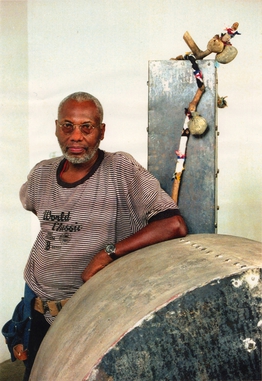John Outterbridge facts for kids
John Outterbridge (born March 12, 1933 – died November 12, 2020) was an American artist. He was also a community activist who lived and worked in Los Angeles, California. His art explored ideas about personal identity, family, and the environment. He often used old, discarded materials in his creations.
John Outterbridge was the first director of the Watts Towers Art Center. He led the center for seventeen years. His sculptures have been featured in The New York Times. Many important museums own his artwork.
Contents
A Look at John Outterbridge's Life
John Wilfred Outterbridge was born and grew up in Greenville, North Carolina. His father recycled metal parts and equipment for a living. This showed John early on how to reuse materials.
He started college at the Agricultural and Technical University in Greensboro, North Carolina. There, he studied to become a mechanical engineer. A year later, Outterbridge joined the military. During his time serving, he became very interested in art. After leaving the military in 1956, he studied at the Chicago Academy of Art. He later attended the American Academy of Art.
In the 1960s, Outterbridge got married and moved to Los Angeles. He became a respected community activist and educator. From 1975 to 1992, he was the director of the Watts Towers Arts Center.
In 1991, Outterbridge retired from his director role. This allowed him to focus more on his art. He passed away on November 12, 2020, in Los Angeles. He was 87 years old.
Creating Art: John Outterbridge's Journey
While serving in Europe, Outterbridge visited museums. He also painted street scenes in his free time. People liked his paintings. He created murals and artwork for offices, clubs, and American schools.
After moving to Los Angeles, Outterbridge began to mix painting with collecting objects. His first major steps into assemblage were car sculptures. He made these from stainless steel found in a junkyard. Assemblage is an art form where artists create 3D artworks by putting together found objects. Outterbridge believed the materials society used told a lot about people's attitudes and history.
Art Inspired by Change
Some of his most famous early works were made during the Watts Riots. From 1963 to 1971, protests and civil unrest happened in Black communities across the nation. This led to the signing of the Civil Rights bill. It showed that race relations were a big problem in the USA. Outterbridge collected trash and items from the streets after these events. He used them to create sculptures. His art from this time was very political. It led him to keep exploring these themes in his work.
Through this, Outterbridge became friends with other artists. They were also interested in similar topics. These artists included David Hammons, Timothy Washington, and John T. Riddle Jr. Together, they helped bring back the California Assemblage Movement. Outterbridge became a very important artist in this movement.
The Containment Series (1968) was another example of Outterbridge's assemblage art. He was interested in how things are "contained" or held back. He wanted to challenge the rules that kept people or ideas contained. To do this, he changed traditional canvases. He covered them with items like aluminum panels, bolts, and leather belts. Outterbridge often used the natural, muted colors of the objects he found. He saved brighter colors for important parts of his art.
History in Art
Outterbridge included history in many of his pieces. Case in Point, from his Rag-Man series, looks like a piece of luggage. It reminds people of dynamite. It also symbolizes the Great Migration. This was when many African Americans moved from the Southern US to other parts of the country. A tag on the luggage says, "packages travel like people." Case in Point highlights the unfair treatment African Americans faced at home. This was especially true after they served the country in the Korean War.
Outterbridge had a successful life. However, his work in education and community activism took time away from his art career. Also, there was quiet racial segregation in the art world until the 21st century. Because of this, Outterbridge did not get much recognition for his work outside the West Coast until 1994. That year, he represented the United States at the São Paulo Biennale. This was a big art show called The Art of Betye Saar and John Outterbridge: The Poetics of Politics, Iconography and Spirituality. Nearly 20 years after he started as a professional artist, a new generation began to appreciate his many artworks.
Outterbridge showed his art in many group and solo exhibitions. One important show was The Rag Factory (2011) at LAXART. This was his first solo exhibition since 1966. The Rag Factory was an art installation. It used rags that Outterbridge collected from the streets and factories of downtown Los Angeles. He tied, draped, folded, gathered, and hung these rags to create the art.
Awards and Recognition
In 2012, the California African American Museum gave Outterbridge a lifetime achievement award. He was named a United States Artists Gracie Fellow for Visual Arts in 2011. In 1994, he received an honorary doctorate from Otis College of Art and Design. Outterbridge also received special awards from the Fulbright Foundation, Getty Foundation, and the National Endowment for the Arts.


